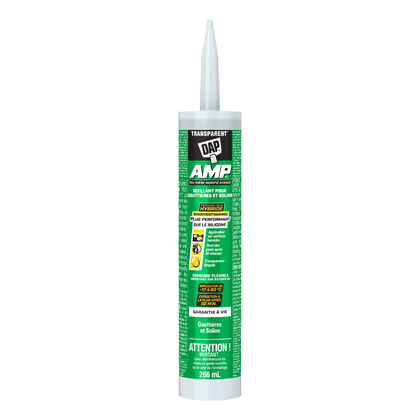DAP AMP Gutter & Flashing Sealant
AMP Advanced Modified Polymer Gutter and Flashing Sealant offers swift 30-minute drying for a dependable, weatherproof seal, that meets ASTM Class 25 standards. Perfect for exterior use, it's ideal for secure flashing installations.
Key Features
-
 paintable
paintable -
 Quick Drying
Quick Drying -
 Exterior Use
Exterior Use -
 Meets ASTM C920
Meets ASTM C920
Product Awards
DETAILS + SPECIFICATIONS
- Details
-
Specifications
SKU Code Unit Size Color Dimensions (in.) Weight Case Pack Cases/Pallet 7079870765 70765 266 ML CRYSTAL CLEAR 8x6x12 12.15 lbs. 12 108
RESOURCES + FAQs
- Technical Data
-
FAQs
Where can I use AMP Gutter and Flashing?
AMP Gutter and Flashing can be used for sealing gutters, drain spouts, lap joints, flashings, roof vents, pipes, ducts, skylights, corrugated roofing, aluminum and vinyl siding, metal joints, and chimneys.
What types of materials can I use AMP Gutter and Flashing Sealant on?
AMP Gutter and Flashing Sealant is safe for Wood – painted & unpainted, vinyl, most plastics, rubber, PVC, aluminum, most metals, fiber cement, concrete, mortar, stone, brick, glass, fiberglass, stucco, most common building materials.
When is AMP Gutter and Flashing Sealant water and rain ready?
AMP Gutter and Flashing Crystal Clear can be exposed to water and rain in just 30 minutes when applied with a bead size maximum of 3/16” in a 65°F and humidity of 50% minimum. AMP will not wash out or become damaged by permanent water and rain marks, eliminating the worry of a ruined caulk job and having to reapply. This is significantly shorter compared to other sealants which typically require anywhere from 4 to 24 hours of wait time before exposure to water.
Is AMP waterproof? Can I use it under water?
AMP Gutter and Flashing Sealant provides a 100% waterproof and weatherproof seal and is water ready in 30 minutes. It can be applied on to wet or damp surfaces, reducing the amount of prep time, work, and reliance on perfect weather conditions. While AMP is waterproof, DAP does not recommend for continuous underwater use, like a below grade drain.
What is the temperature range application for AMP?
AMP can be applied in extreme temperature ranges – from 0°-140°F without needing perfect weather conditions to complete the job.
What does the C920 standard mean in regards to flexibility?
AMP Gutter and Flashing provides maximum flexibility and passes the standard ASTM C920, class 25 for clear. This ASTM specification tests the properties of a cured elastomeric joint sealant to understand how the sealant withstands expansion and contraction of joint movement in extreme temperatures.
Can I apply AMP on wet surfaces?
Yes - AMP can be applied on wet and damp surfaces, improving efficiency.
How long does AMP last?
AMP is shelf stable for a minimum of 12 months from the date of production in an unopened tube.
How much coverage does AMP provide per cartridge?
AMP covers 49 linear feet at the recommended 3/16” bead.
If I only use half of a cartridge, can I use the other half of AMP at a later date? If so, what are the proper storage conditions?
Yes, the remaining product can be used when stored properly. If there is remaining product within the nozzle, seal the nozzle tip, and store below 80°F in a dry place. When ready to use again, remove cured product remaining in the nozzle and cut a new tip if desired.
What is needed to clean up AMP sealants?
Mineral spirits or any other solvent is required to clean up AMP sealants. If uncured AMP sealant needs to be cleaned up, scrape up as much excess product as possible, using a razor blade or non-abrasive scouring pad on natural or fiberglass surfaces, then use mineral spirits in a well-ventilated area to wipe away excess sealant. Avoid using solvents on skin.
Can I just apply AMP over my existing sealant?
In order to have the best product performance and adhesion, it is recommended to not apply over old sealants and to fully remove existing sealant and clean and prep the surface.
What’s the ideal recommended nozzle size to get the perfect bead?
To get the perfect bead size, cut along the indicated 3/16” bead marking, at a 45°angle, on the AMP nozzle tip for optimal joint protection.
Do I need to prep my seam before I caulk?
Surface preparation is important to ensure the best adhesion of the sealant to the substrate. We recommend all surfaces be clean, structurally sound and free of old caulk and foreign material the same day you plan to apply the product. If the joint width exceeds 1/2”, use a foam backer rod.







